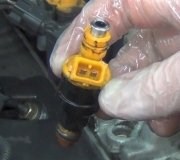Injectors actually cause extremely little trouble. The biggest exception is with GM engines. It isn't that their injectors fail. They have a lot of elusive cylinder misfire problems because they don't install flow-matched sets of injectors, then, at high mileage, they flow different volumes leading to those misfires. The driver can't feel them, but the Engine Computer can detect them.
This is the problem you could create by replacing just one injector. Standard practice is to replace them in a matched set. Part numbers can change for a number of reasons. If changes or improvements are made to the design, they'll get a new part number. For that reason, this type of part is purchased by application. Sometimes you'll find a replacement has an original part number included in the item listing, but that is for reference to insure you're looking at the right part. If you look at online auto parts stores, you'll often find they include a half dozen manufacturer's part numbers as cross referencing to their new part.
You mentioned "used" part. I would find that perfectly acceptable to harvest a set from a vehicle in a salvage yard because these do have such a low failure rate. The need to program computers to the specific vehicle is one of many tricks developed by GM, but it does not apply to injectors. There's no computer circuitry inside an injector, so you can just plug them in and buzz off into the sunset. If the replacements flow a little more or less volume, that will be picked up by the oxygen sensors as a slightly rich or lean condition, then the Engine Computer will make rapid adjustments to the amount of time it pulses the injectors open. That is called the "short-term fuel-trim", (STFT) numbers. Those update constantly while you're driving. Over time, when the computer sees it is always making the same short-term adjustments, it will transfer those adjustments to the "long-term fuel-trim", (LTFT) numbers it has in memory. From then on, those are what it considers "normal", and it starts out using them each time you start the engine. Both of those numbers can be read on a scanner to give an idea as to whether the fuel system is operating normally.
If it will help, here's a link to an article about replacing injectors:
https://www.2carpros.com/articles/how-to-replace-a-fuel-injector
SPONSORED LINKS
Friday, January 3rd, 2020 AT 5:45 PM




